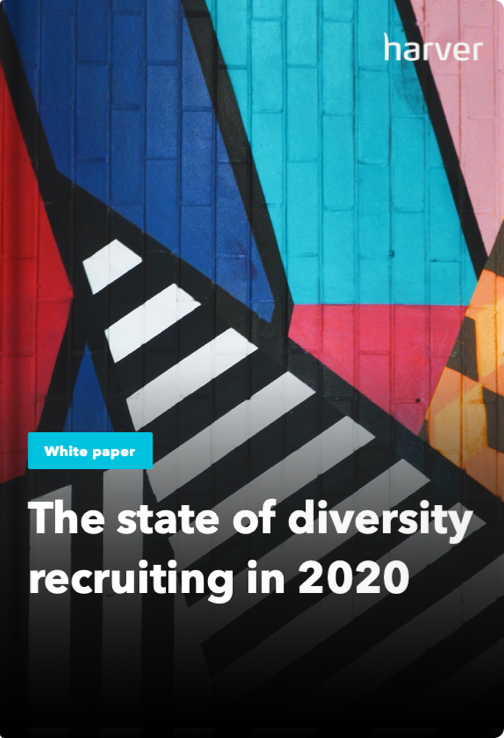Publishing a job posting and crossing your fingers isn’t the best strategy to attract the right talent.
The same goes for filling in skills gaps only after the situation at your organization starts to be critical. That’s why you need to have proactive recruitment strategies in place. And when you consider that 67% of employed American adults would change their mind about a job based on their candidate experience, your recruitment strategy must be working for your candidates as much as it is for you.
As an employer, creating a proactive recruiting strategy creates a doorway to controlling and improving your candidate’s experience and attracting great talent.
Let’s take a closer look at what proactive recruitment is, and the strategies you can use to implement it in your workplace.
What’s in?
- What is proactive recruitment?
- How can proactive recruitment help you?
- What are the proactive recruitment strategies you can use?
Like what you see?
Don’t miss out. Subscribe to our quarterly digest to get the latest TA and TM resources delivered right to your inbox.
What is proactive recruitment?
Proactive recruitment is a strategy that focuses on sourcing, engaging, and attracting candidates ahead of hiring demand.
Unlike reactive recruiting, which relies on candidates applying for a position once its open, proactive recruitment searches for the right people before you need them. Once they’re found, proactive recruitment then differentiates itself from reactive recruiting by establishing contact with candidates, building relationships with them, and creating interest around your employment opportunities.
To be able to start recruiting proactively, you first need to have a recruitment plan that ties in with your strategic workforce planning.

Despite low unemployment rates, talent professionals believe that people are always looking for new, attractive opportunities. By utilizing proactive recruiting strategies, you’re able to reach these people effectively.
Approaching proactive recruitment requires going through a five-phase process.
Five crucial phrases of proactive recruitment
Phase 1: Find
The first phase of proactive recruitment relies on reaching out to candidates who you feel are likely to become candidates and long-term, engaged employees at your company. Simply put, you don’t want to be reaching out to everyone.
This requires talking to your current team, especially your recruiters or hiring managers, to create an ideal candidate profile per role or department. Doing so not only helps you narrow down what type of candidate you’re looking for but saves you a ton of sourcing time.
The best way to find candidates that match your ideal profile is by utilizing social platforms, your own candidate database, events, and relevant communities (but we will get into all of this a little later).
Phase 2: Engage
Remember, hiring the right talent is a two-way street. Proactive recruiting relies on you piquing the interest of your ideal candidate once you’ve found them.
It’s crucial to remember that while you may have found someone who matches your ideal candidate profile, they’re not you’re candidate yet. Engaging a candidate should be done by sending them a personalized, crafted message about what your company is about, and starting a conversation with them about what they’re looking for in a job role.
Phase 3: Nurture
Nurturing candidates is a crucial part of any proactive recruitment strategy, and it should be viewed in a similar way to how sales reps nurture their prospects.
Not only does nurturing candidate relationships help keep candidates interested in what’s happening in both camps, but it can also help keep your company at the top of a job-seekers mind if they begin to look for a career change. Small steps, like keeping in touch via emails, content, and social media, can really strengthen relationships with candidates.
Phase 4: Attract
As a recruiter, by step four, you’ve already laid the foundations for attracting the right prospective candidates to your company. The attraction stage relies on engaging with candidates who are further down your recruitment funnel who have a higher chance of taking an open position at your company.
With modern-day recruitment tech, this has become less of a headache than it was in the past. For example, recruiters can now automatically send emails filled with relevant content that encourages those that are ready to apply for open positions using the right tech, for example, a candidate relationship management tool.
Phase 5: Convert
Once a prospective candidate applies, it’s up to you to make sure the experience with your company not only meets but exceeds their expectations.
Again, using recruiting software, recruiters can now keep an applicant in the loop about the progress in their recruitment process automatically, for example, by triggering automated actions based on a candidate’s status.
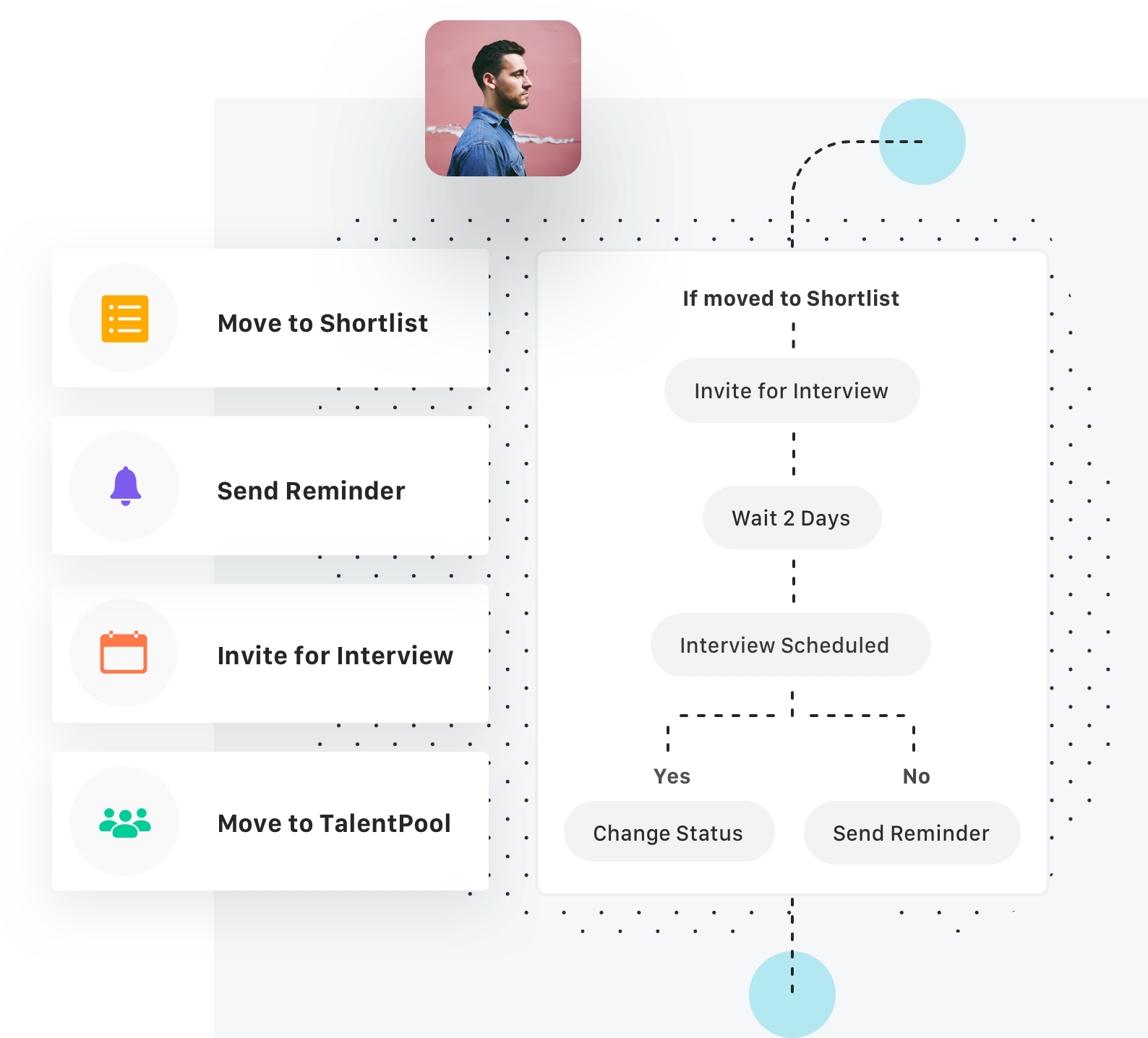
Keeping your candidates in the loop is crucial for a couple of reasons. If they don’t get the position, you still want your company to be seen in a favorable light. Plus, word-of-mouth is a huge factor in attracting the right talent. If a candidate has a good application experience with your company, they’re more likely to spread the word in their professional circle.
How can proactive recruitment help you?
Engaging in proactive recruitment can bring a host of benefits to the way you hire staff.
Not only does it cut down on the time it takes to hire the right people, but it also paves the way for better hiring and interviewing process.
Let’s take a more in-depth look at what that means.
Less time hiring = more time working
The standard way to hire people is transactional. It requires the right people coming to you.
But if you flip that process on its head and proactively seek out the best candidates for the job, a lot of the groundwork of building relationships has already been done. By working proactively, recruiters can not only forecast their hiring needs more accurately but also map out what they’re looking for in advance. Building a pipeline around anticipation can cut down the time it takes to hire the right staff and allow you to evaluate talent when the time comes effectively.
Improved hiring and interviewing = happier candidates
When you talk a candidate, remember that they’re interviewing you as well. If they don’t have a great experience, they’re unlikely to move forward with the employment opportunity and consider your offers in the future.
Employing a proactive recruitment strategy allows you to interview better and create a streamlined process for hiring the right people. As you’ve already built up a relationship with a candidate before you interview them, proactive recruiting allows both parties to be more open and honest about what they’re expecting from the role.
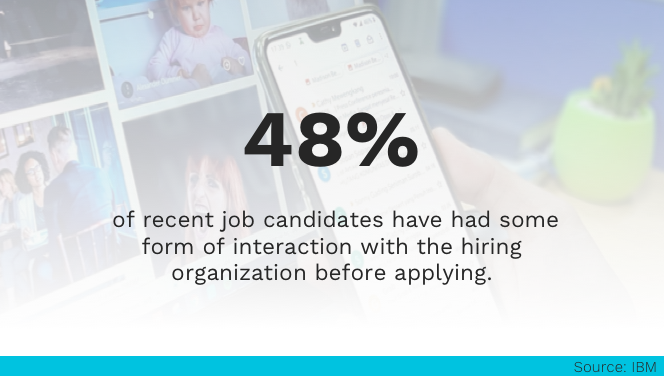
Candidates engage with companies early on in their job search process. A proactive recruitment strategy helps you reach them and shape their vision of your company.
What are the proactive recruitment strategies you can use?
1. Building a talent community
It’s essential to create a talent community to attract applicants who are interested in your company but may not be ready to apply just yet.
Talent communities are a way to keep your recruitment channel open, 24/7. Using a portal, you can invite people to leave their names, email, and what job family they’re interested in. Think of it as a modern way to keep a CV on file.
If you think about the journey a candidate takes when they’re looking for a new job, talent communities make sense. Before a person applies for a job at your company, they’ve likely investigated your company by perusing your career page, social media channels, and reviews from past and current employees. They might decide to keep looking on your site or make a mental post-it note to come back later.
Now, if you don’t have a position that fits their skill set, not only can they not apply to your company, they’re likely to forget about you and look elsewhere. With a talent community, you can capture this enthusiasm a candidate has for your company, and encourage them to tell you more about themselves and what they’re looking for.
Then, you can stay on their radar through email, event invites, and content, like Trivago’s talent community does.

Trivago makes sure to offer its career site visitors an alternative if they don’t see their dream job listed right away.
However, talent communities aren’t just website portals. You can also build one on a Slack thread or social media groups, so don’t be afraid to get creative.
2. Perfecting your online visibility
Boosting your SEO and social media efforts can help with your online visibility to candidates.
The good thing about building a presence online is that a lot of the channels used by recruiters intertwine with each other. For example, having a Twitter and LinkedIn presence can help bolster your SEO visibility, which in turn makes it more likely your website will be shown to potential candidates.
And now, many platforms favored by recruiters have launched their own business-style platforms. For example, Facebook now has Facebook for Business, and LinkedIn has LinkedIn Recruiter.
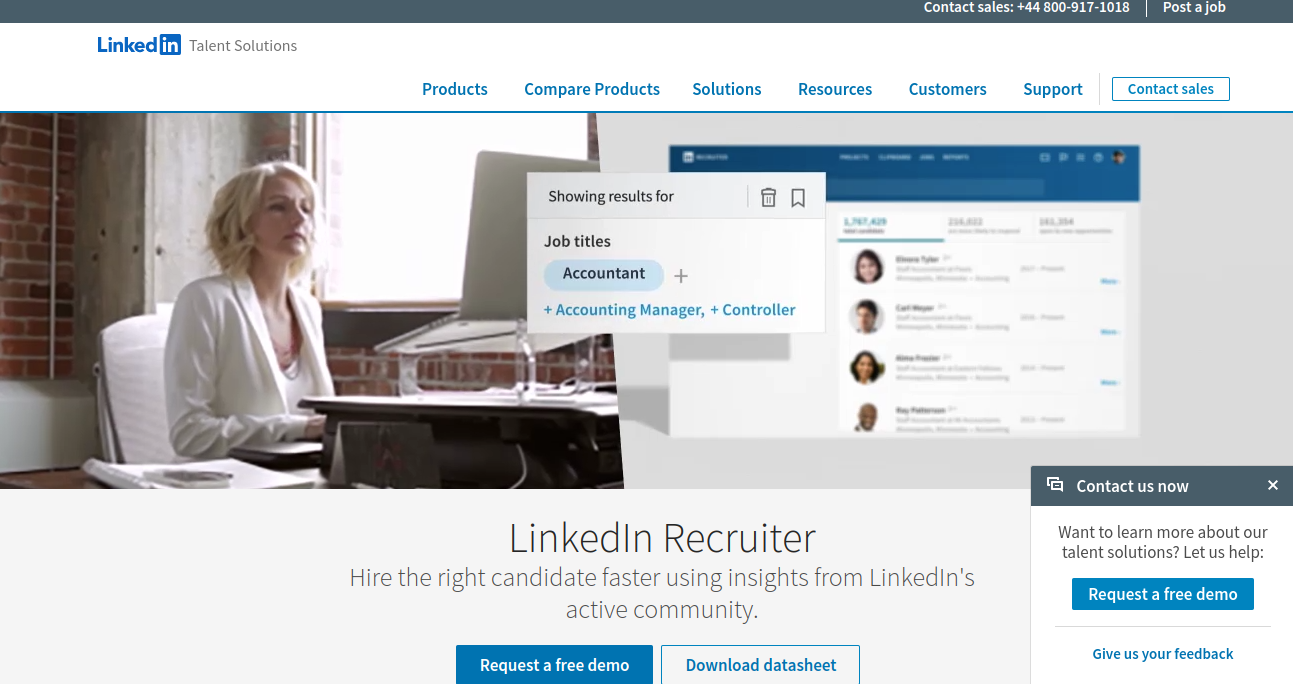
LinkedIn Recruiter lets you find candidates more easily and efficiently.
Utilizing recruiting tools that are available to you to make your online presence stand out is the key to finding and engaging the right talent. After all, your online visibility can play a role in a candidate’s decision about whether you are a good fit for them as an employee.
Don’t forget to make sure your online presence is mobile-friendly, too. A lot of job seekers are now applying for roles from their mobile devices. An Indeed study found that 78% of Millennials, 73% of Gen Xers, and 57.2% of “Baby Boomers” used their mobile devices for job hunting. Not optimizing your online presence for mobile could cause you to miss out on quality candidates.
3. Taking advantage of networking opportunities
Networking is one of the oldest channels of recruiting, but networking in proactive recruitment is a little… different.
Sure, you need to be looking at the traditional offline networking opportunities like attending job fairs and conferences geared at your industry. They’re still a great way to meet people in your sphere and attract talent.
Yet taking advantage of current networking opportunities like Slack, Facebook, Twitter, and even Instagram can be a great way to build relationships with future candidates. Let’s say your company wants to hire some new developers. A community like CodeNewbie, where programmers and people learning to code hang out, can be a goldmine for recruiters. Better yet, they have a dedicated Slack channel. Recruiting on Reddit can be another proactive way of finding (especially tech) talent.
Niche communities like these give recruiters an alternative way to headhunt top talent, away from the big sites like LinkedIn. There is less competition to stand out as an employer, and candidates will be more likely to respond to you in a community where they’re seeking out a job.
Think of this one as a way to talk to prospective candidates in a virtual water-cooler environment.
The state of diversity recruiting in 2020
4. Creating an easy application process for candidates
Job hunting is hard. Taking away some of the pain can and making the application process easy for candidates can win you a lot of brownie points.
One of the first steps you should take is looking at your application process. Are you only asking candidates for information that’s essential, or are you making them jump through hoops with a 30-minute application?
Make your application process easy, and cut out any part of it that’s unnecessary.
Recruiters must realize that today’s candidate-driven market is about the candidate’s experience. Using a proactive recruitment strategy allows you to hire in a way that’s not “needs-must,” and helps the application process run more organically. If your hiring process is built around just finding the best person for the job, and not trying to fill an employment hole, it helps to create a more positive application experience for your candidates.
5. Sending candidates engaging and relevant content
Keeping candidates engaged with content is one of the best ways to build a relationship with them.
How you engage with candidates will depend on what channel you’re reaching them through, but a good rule of thumb is to include content like videos (to increase engagement) or updates about company roles. For example, Unilever uses email to engage with potential candidates and offers personalized content. Furthermore, the company uses a chatbot to actively entice its website visitors to join their talent network.
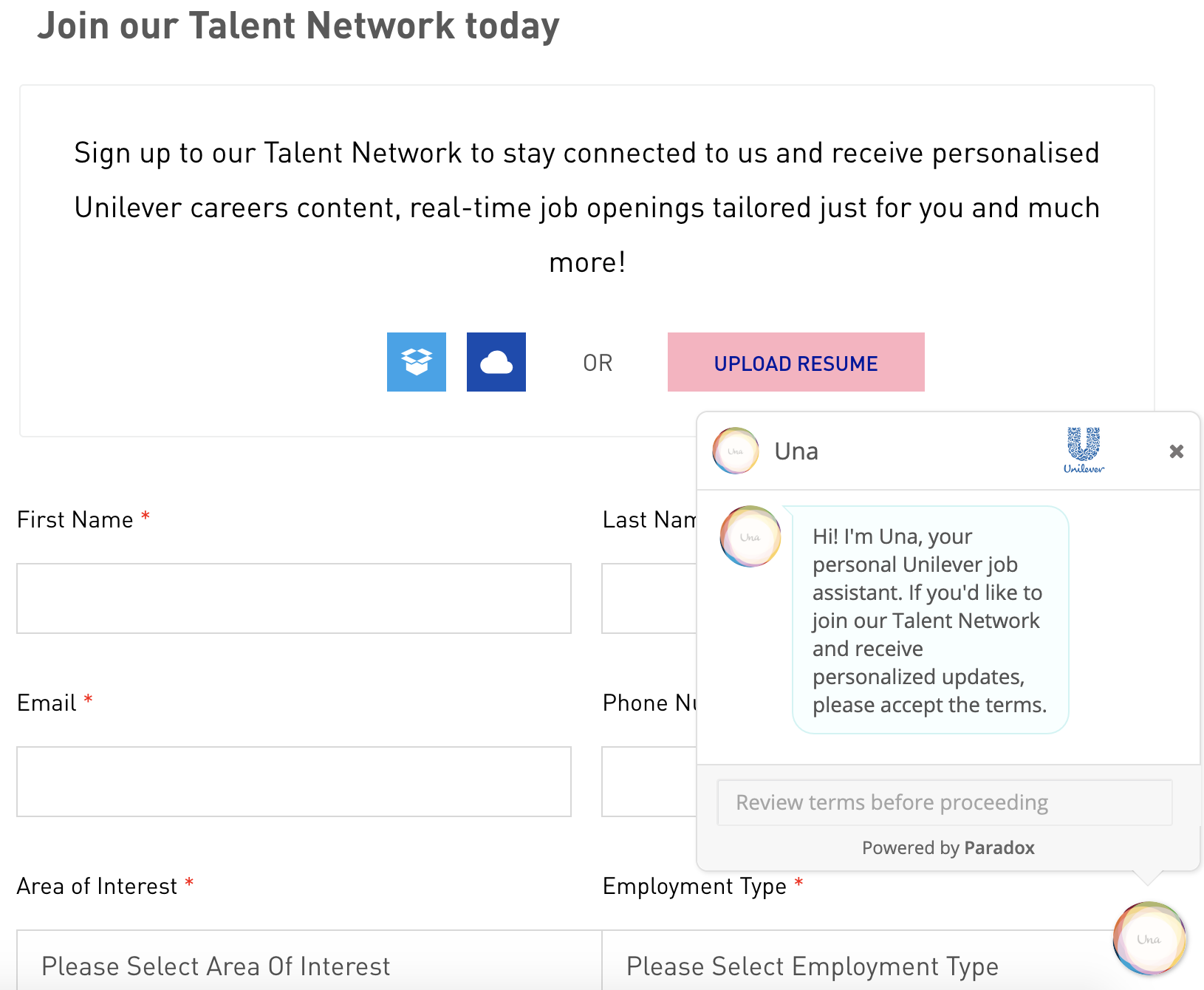
If you’re looking for ways to use the content on social media, you can try 30-second videos with subtitles that are adapted to Facebook or Twitter feeds, where people are inclined to scroll down with the sound off. If you’re targeting candidates on Twitter, you can adapt GIFs or static images that can be retweeted or prompt a discussion.
6. Having a great career site that captures your company culture
A career site can say a lot about your company, its values, mission, and team.
Career sites have become a vital way for companies to attract talent and build a successful recruitment pipeline. In fact, two-thirds of job seekers look at a company’s career page after they hear about a job opportunity. And as the average career page converts at around 18%, it pays to invest in a page that’s going to appeal to potential candidates.
But what does a great career site look like?
Take a look at the career page Zappos has built. It’s a perfect reflection of the values at the company: delivering happiness, embracing change, and creating fun.
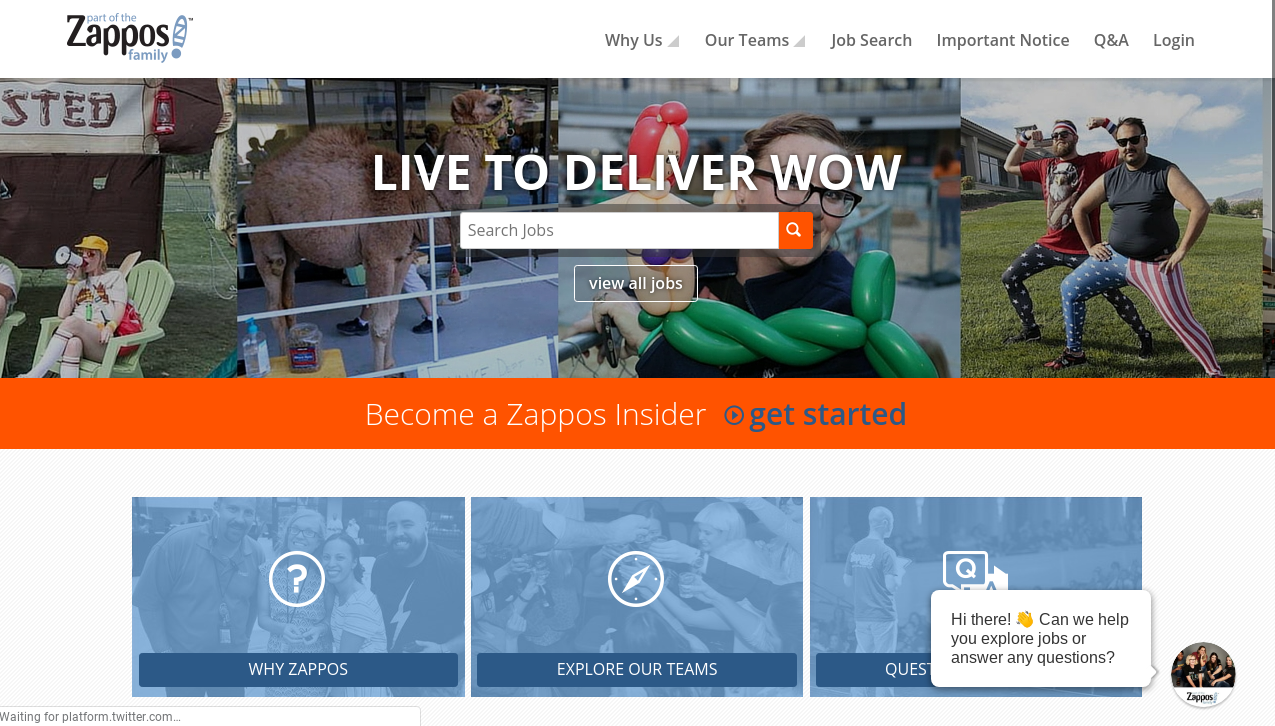
Not only is the purpose-built site easy to navigate, but it also has dedicated pages that give a detailed breakdown of what job roles entail, testimonials from current employees, and even a useful chatbot.
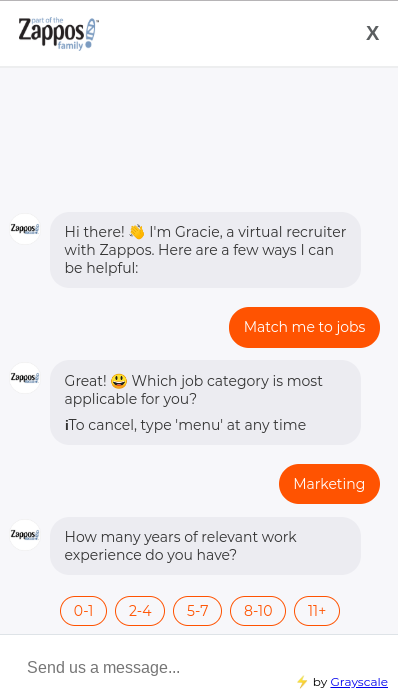
Wrapping up
Being proactive in your recruitment efforts pays off.
To make proactive recruitment work, however, you will need to adjust your overall strategy. Most importantly, you have to adjust your mindset.
Proactive recruitment requires you to move away from traditional methods like regular job posting (not to say you shouldn’t do that as well) and start anticipating the needs of your company. Sometimes this requires sharpening your company’s online presence and career site, as well as looking at alternative recruitment strategies like Slack and content engagement.
Whatever works for your company in the way of proactive recruitment, the ultimate goal will be bringing the right talent to your organization.
The state of diversity recruiting in 2020

